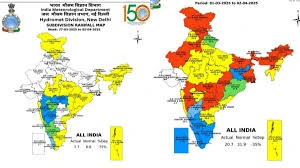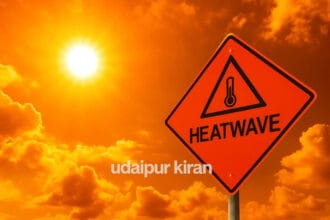- North India April heatwave climate change concerns are intensifying after new studies linked the region’s extreme temperatures to global warming. Experts say this event is yet another example of how climate change is contributing to more frequent and intense heatwaves across India.

Delhi, New Delhi: Scientists working with ClimaMeter, a consortium of organizations and professionals that analyze extreme weather events in the context of climate change, have suggested that the heatwave that swept across north India and Pakistan in mid-April may have been significantly influenced by climate change.
Their examination of weather data from the 1950s to the present indicates that the heatwave in April was a “very exceptional” meteorological occurrence. It was significantly influenced by climate change rather than by the inherent variability of the climate.
And more heatwaves are brewing in India as the summer progresses. As part of the ongoing North India April heatwave climate change trend, the India Meteorological Department stated on April 21 that another heatwave is likely to impact parts of central and north India from April 21 to 26.
North India April Heatwave Climate Change Link Confirmed by Experts

Heatwaves, according to the India Meteorological Department, are times when temperatures in a location are abnormally high relative to the average for that time of year. Heatwaves have been linked to human activity, although meteorological factors, including low wind speeds, can also raise local temperatures.
For instance, the sixth assessment report of the Intergovernmental Panel on Climate Change (IPCC), a body under the United Nations, concluded in 2021 that human activities—such as the burning of fossil fuels and the resulting greenhouse gas emissions—have significantly contributed to the increased frequency and intensity of extreme climate events, including heatwaves. This supports concerns about the North India April heatwave climate change connection and the role of human-induced global warming in shaping regional weather extremes.
Heatwaves are categorized as an extreme weather occurrence brought on by climate change in this way.
India and Pakistan witnessed a severe heatwave in April this year. As part of the ongoing North India April heatwave climate change pattern, India experienced unusually early high temperatures—beginning around April 8. By April 11, parts of northwest India, including the capital city of Delhi, recorded temperatures exceeding 40 degrees Celsius. The India Meteorological Department (IMD) issued red alerts for several affected areas, highlighting the intensifying impact of climate change on regional weather
The meteorological factors that contributed to the April heatwave were examined by scientists with ClimaMeter, a consortium of organizations and specialists who analyze extreme weather occurrences in the context of climate change.
The team accessed reanalysed satellite data (ERA5) to examine how meteorological conditions have changed in recent decades—from 1987 to 2023—compared to the earlier period of 1950 to 1986. In the context of the North India April heatwave climate change debate, the findings were intriguing: similar heatwave-related meteorological patterns—such as surface or atmospheric pressure, rainfall, and wind speeds—occur with roughly the same frequency now as they did in the past. This suggests that while background climate conditions remain consistent, the intensity and impact of heatwaves may be shaped more by other climate change-driven factors.
The heatwave of April 14 and 15 was more than 4 degrees Celsius warmer than it would have been in the past, despite the significant temperature swings. The scientists also discovered that the temperature has risen in Pakistani cities like Islamabad, Jaipur, and New Delhi. The city that was most impacted was Islamabad, where temperatures rose by up to three degrees Celsius.
However, El Nino and La Nino, which are components of the El Nino-Southern Oscillation (ENSO) phenomena, are examples of natural climatic variability that could impact temperatures to o. El Niño years, for example, are frequently linked to warmer temperatures or more precipitation worldwide. For example, throughout the majority of South Asia, an El Niño results in a normal to below-average southwest mons Soon.
But when scientists analyzed this possibility, they found that ENSO conditions played only a very small role in the North India April heatwave climate change scenario. This is because the region is currently experiencing an ENSO-neutral phase—a period when neither El Niño nor La Niña conditions are active—indicating that other climate-related factors may be responsible for the intensifying heatwave.
Their report, published on April 18, concludes that the warmer temperatures during the North India April heatwave climate change event—specifically on April 14 and 15 across India and Pakistan—can be largely attributed to human-induced climate change.
It must be noted, however, that this report on the North India April heatwave climate change is not yet peer-reviewed, although the methodologies it employed are scientifically recognized. Due to limited data available for analysis—given that such a heatwave is not only rare but described as “very exceptional”—the scientists have also acknowledged low confidence in the overall robustness of their findings.
“Considering the available climate data, we have low confidence in the robustness of our approach for this event because it is highly exceptional in the database.”
Another heatwave looms over central and north India
“The North India April heatwave climate change crisis gripping India and Pakistan underscores an alarming intensification of climate extremes, profoundly affecting millions throughout the region,” Gianmarco Mengaldo, a scientist at the National University of Singapore, said in a press statement.
Heatwaves are becoming more frequent in the tropical Indo-Pacific region due to a change in weather patterns. Extreme weather circumstances highlight serious weaknesses in food security, healthcare systems, and critical infrastructure when temperatures rise toward thresholds that challenge human survival. In order to overcome upcoming climatic issues, this calls for quick action and increased resilience.
Meanwhile, another heatwave is brewing. According to the India Meteorological Department (IMD), parts of north and central India are likely to experience heatwave conditions between April 21 and 26, continuing the pattern of North India April heatwave climate change. In a press release on April 21, the IMD warned that isolated areas in east Rajasthan would likely face heatwave conditions from April 21 to 26.
Similar circumstances may exist in Chhattisgarh, Madhya Pradesh, and the Vidarbha area of Maharashtra from April 21 to 25. Haryana, Odisha, and portions of Uttar Pradesh are expected to suffer heatwave conditions from April 22 to April 26. Similarly, on certain days between April 23 and 26, heatwaves may also occur in portions of Punjab, West Bengal, and western Rajasthan. In the meantime, April 25 and 26 may see scorching conditions in Bihar and Jharkhand.
















